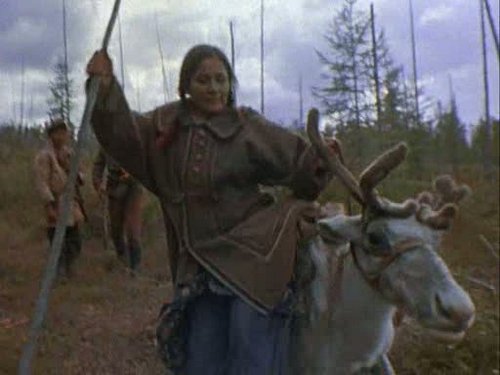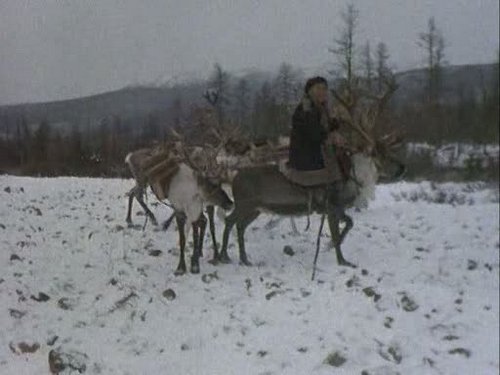The Evil Spirit of Yambuy was enjoyable to watch even though the plot was nothing special. The scenery was good and would probably look even better if we had a high quality version of the film. Some of the characters are interesting, though there isn’t much in the way of character development. It’s the novelty of the setting and the culture that held our attention.
A team of surveyors is finishing up its work in eastern Siberia in 1949 and heading home when they learn of the disappearance of other surveyors in the region of the Yambuy mountain. They go back to look for them. Some of the native Evenki herders offer advice, such as “Don’t be stupid, there is an evil spirit there.” The old woman, Yangara, especially has a charming way of dispensing advise and information. The Evenki knowledge of the region and its inhabitants proves to be indispensable to the Russians, who are far from home.
I liked the inevitable bear-human encounters in this film better than those in adventure movies that we used to take our kids to see on Saturday afternoons, mainly because the violent encounters are not drawn out to wearisome length.
More interesting than the bears are the reindeer. I had known that reindeer could pull a sleigh (and not only on Christmas Eve) but had no idea that they could be saddled and ridden. I don’t recall that the movie ever showed anyone climbing into the saddle, but the dismounting technique is very graceful, considering that it’s done without first bothering to bring the animal to a stop: Swing your left leg around in front of you and step off in one quick and easy motion. It went so quickly that it was hard to get a screenshot of the above woman doing it. Here she is shown almost at the end of the motion.
After watching the film, I went to google to learn more about reindeer and the people who live with them. How domesticated are these caribou, really, and how does one go about training one to be useful? That led me to a fascinating book, “The reindeer people: living with animals and spirits in Siberia” by Piers Vitebsky (2005).
One thing I learned is that although domestication of caribou has taken place only recently, i.e. over the past 3000 years, good luck trying to domesticate a caribou now and turn it into a reindeer. It won’t happen.
The two are a single species and can interbreed. Caribou males can and will come in to camp to impregnate reindeer females. Reindeer can run off and join a caribou herd, never to be seen again. But nobody has succeeded in taming a wild caribou in recent times.
I also learned that different peoples in northern Asia and Europe use reindeer differently. The Sami people of northern Scandinavia don’t ride theirs. The people who do ride reindeer don’t all use the same methods. Some groups ride on their backs, using a saddle and stirrups like are used on horses. But the Evenki people in this film place the saddle on the shoulders of the animal. Instead of stirrups, they tap the ground with a long staff to help keep their balance. The reindeer can carry loads on their shoulders much further without tiring than they can on their backs.
Piers Vitebsky spent some time among Eveny people, who are similar to the Evenki in the film. When perestroika first came to the Soviet Union, he took the opportunity to go and learn how their subsistence economy and shamanic worldview had adapted to Soviet rule.
It’s not as though opportunity came in the form of an open door and eager invitations, though. It took years of preparation and great persistence in dealing with recalcitrant bureaucrats. In Vitebsky’s telling, he seems to be what Indiana Jones would have been if he had been a real person (and if he had been an anthropologist instead of an archaeologist). One of my favorite passages so far is this:
We camped on a stony riverbed the first night and I found time to stop being frightened and look around at the wiry figures of my companions in the flickering firelight. After my years of fieldwork in India, their weather-beaten North Asian faces seemed completely new and exotic. Some wore flat caps and some headscarves tied around the backs of their heads. With their rifles and padded cotton convict jackets, they resembled brigands or mountain guerrillas. The vet asked if I had really ridden a horse before.
‘Actually, no,’ I said, ‘but I was afraid you wouldn’t take me if I said so.’
The men roared with laughter. This was my first inkling of the self-reliant and anarchic spirit that coexisted with the delicate discretion of traditional Eveny culture as well as with the nervous fear under Communism of doing anything that was not officially authorized.
I’m getting a real copy of the book so I can read the rest of it, including the parts that aren’t available on Google Books.

